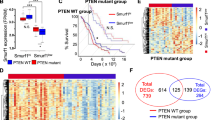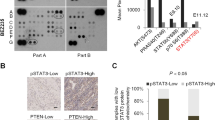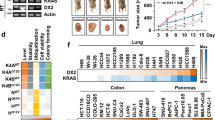Abstract
The mammalian target of rapamycin (mTOR) regulates cell growth by integrating nutrient and growth factor signaling and is strongly implicated in cancer. But mTOR is not an oncogene, and which tumors will be resistant or sensitive to new adenosine triphosphate (ATP) competitive mTOR inhibitors now in clinical trials remains unknown. We screened a panel of over 600 human cancer cell lines to identify markers of resistance and sensitivity to the mTOR inhibitor PP242. RAS and phosphatidylinositol 3-kinase catalytic subunit alpha (PIK3CA) mutations were the most significant genetic markers for resistance and sensitivity to PP242, respectively; colon origin was the most significant marker for resistance based on tissue type. Among colon cancer cell lines, those with KRAS mutations were most resistant to PP242, whereas those without KRAS mutations most sensitive. Surprisingly, cell lines with co-mutation of PIK3CA and KRAS had intermediate sensitivity. Immunoblot analysis of the signaling targets downstream of mTOR revealed that the degree of cellular growth inhibition induced by PP242 was correlated with inhibition of phosphorylation of the translational repressor eIF4E-binding protein 1 (4E-BP1), but not ribosomal protein S6 (rpS6). In a tumor growth inhibition trial of PP242 in patient-derived colon cancer xenografts, resistance to PP242-induced inhibition of 4E-BP1 phosphorylation and xenograft growth was again observed in KRAS mutant tumors without PIK3CA co-mutation, compared with KRAS wild-type controls. We show that, in the absence of PIK3CA co-mutation, KRAS mutations are associated with resistance to PP242 and that this is specifically linked to changes in the level of phosphorylation of 4E-BP1.
This is a preview of subscription content, access via your institution
Access options
Subscribe to this journal
Receive 50 print issues and online access
$259.00 per year
only $5.18 per issue
Buy this article
- Purchase on Springer Link
- Instant access to full article PDF
Prices may be subject to local taxes which are calculated during checkout





Similar content being viewed by others
References
Kantarjian H, Sawyers C, Hochhaus A, Guilhot F, Schiffer C, Gambacorti-Passerini C et al. Hematologic and cytogenetic responses to imatinib mesylate in chronic myelogenous leukemia. N Engl J Med 2002; 346: 645–652.
Kwak EL, Bang Y-J, Camidge DR, Shaw AT, Solomon B, Maki RG et al. Anaplastic lymphoma kinase inhibition in non-small-cell lung cancer. N Engl J Med 2010; 363: 1693–1703.
Chapman PB, Hauschild A, Robert C, Haanen JB, Ascierto P, Larkin J et al. Improved survival with vemurafenib in melanoma with BRAF V600E mutation. N Engl J Med 2011; 364: 2507–2516.
Jänne PA, Gray N, Settleman J . Factors underlying sensitivity of cancers to small-molecule kinase inhibitors. Nat Rev Drug Discov 2009; 8: 709–723.
Joseph EW, Pratilas CA, Poulikakos PI, Tadi M, Wang W, Taylor BS et al. The RAF inhibitor PLX4032 inhibits ERK signaling and tumor cell proliferation in a V600E BRAF-selective manner. Proc Natl Acad Sci USA 2010; 107: 14903–14908.
Laplante M, Sabatini DM . mTOR signaling in growth control and disease. Cell Elsevier Inc. 2012; 149: 274–293.
Sarbassov DD, Ali SM, Kim D-H, Guertin DA, Latek RR, Erdjument-Bromage H et al. Rictor, a novel binding partner of mTOR, defines a rapamycin-insensitive and raptor-independent pathway that regulates the cytoskeleton. Curr Biol 2004; 14: 1296–1302.
Hara KK, Maruki YY, Long XX, Yoshino K-IK, Oshiro NN, Hidayat SS et al. Raptor, a binding partner of target of rapamycin (TOR), mediates TOR action. Cell 2002; 110: 177–189.
Loewith RR, Jacinto EE, Wullschleger SS, Lorberg AA, Crespo JLJ, Bonenfant DD et al. Two TOR complexes, only one of which is rapamycin sensitive, have distinct roles in cell growth control. Mol Cell 2002; 10: 457–468.
Menon S, Manning BD . Common corruption of the mTOR signaling network in human tumors. Oncogene 2008; 27 (Suppl 2): S43–S51.
Sato T, Nakashima A, Guo L, Coffman K, Tamanoi F . Single amino-acid changes that confer constitutive activation of mTOR are discovered in human cancer. Oncogene 2010; 29: 2746–2752.
Shaw RJ, Cantley LC . Ras, PI(3)K and mTOR signalling controls tumour cell growth. Nature 2006; 441: 424–430.
Iyer G, Hanrahan AJ, Milowsky MI, Al-Ahmadie H, Scott SN, Janakiraman M et al. Genome sequencing identifies a basis for everolimus sensitivity. Science 2012; 338: 221.
Motzer RJ, Escudier B, Oudard S, Hutson TE, Porta C, Bracarda S et al. Efficacy of everolimus in advanced renal cell carcinoma: a double-blind, randomised, placebo-controlled phase III trial. Lancet 2008; 372: 449–456.
Hudes G, Carducci M, Tomczak P, Dutcher J, Figlin R, Kapoor A et al. Temsirolimus, interferon alfa, or both for advanced renal-cell carcinoma. N Engl J Med 2007; 356: 2271–2281.
Apsel B, Blair JA, Gonzalez B, Nazif TM, Feldman ME, Aizenstein B et al. Targeted polypharmacology: discovery of dual inhibitors of tyrosine and phosphoinositide kinases. Nat Chem Biol 2008; 4: 691–699.
Feldman ME, Apsel B, Uotila A, Loewith R, Knight ZA, Ruggero D et al. Active-site inhibitors of mTOR target rapamycin-resistant outputs of mTORC1 and mTORC2. Plos Biol 2009; 7: e1000038–e1000038.
Thoreen C, Kang S, Chang J, Liu Q, Zhang J, Gao Y et al. An ATP-competitive mTOR inhibitor reveals rapamycin-insensitive functions of mTORC1. J Biol Chem 2009; 284: 8023–8032.
García Martínez JM, Moran J, Clarke RG, Gray A, Cosulich SC, Chresta CM et al. Ku-0063794 is a specific inhibitor of the mammalian target of rapamycin (mTOR). Biochem J 2009; 421: 29–42.
Zhang Y-J, Duan Y, Zheng XFS . Targeting the mTOR kinase domain: the second generation of mTOR inhibitors. Drug Discov Today 2011; 16: 325–331.
Dowling RJO, Topisirovic I, Alain T, Bidinosti M, Fonseca BD, Petroulakis E et al. mTORC1-mediated cell proliferation, but not cell growth, controlled by the 4E-BPs. Science 2010; 328: 1172–1176.
Markowitz SD, Bertagnolli MM . Molecular basis of colorectal cancer. N Engl J Med 2009; 361: 2449–2460.
Lièvre A, Bachet J-B, Boige V, Cayre A, Le Corre D, Buc E et al. KRAS mutations as an independent prognostic factor in patients with advanced colorectal cancer treated with cetuximab. J Clin Oncol 2008; 26: 374–379.
McDermott U, Sharma SV, Dowell L, Greninger P, Montagut C, Lamb J et al. Identification of genotype-correlated sensitivity to selective kinase inhibitors by using high-throughput tumor cell line profiling. Proc Natl Acad Sci USA 2007; 104: 19936–19941.
Hsieh AC, Liu Y, Edlind MP, Ingolia NT, Janes MR, Sher A et al. The translational landscape of mTOR signalling steers cancer initiation and metastasis. Nature 2012; 485: 55–61.
O’Reilly KE, Rojo F, She Q-B, Solit D, Mills GB, Smith D et al. mTOR inhibition induces upstream receptor tyrosine kinase signaling and activates Akt. Cancer Res 2006; 66: 1500–1508.
Cloughesy TF, Yoshimoto K, Nghiemphu P, Brown K, Dang J, Zhu S et al. Antitumor activity of rapamycin in a Phase I trial for patients with recurrent PTEN-deficient glioblastoma. PLoS Med 2008; 5: e8.
Blaser B, Waselle L, Dormond-Meuwly A, Dufour M, Roulin D, Demartines N et al. Antitumor activities of ATP-competitive inhibitors of mTOR in colon cancer cells. BMC Cancer 2012; 12: 86.
Atreya CE, Ducker GS, Feldman ME, Bergsland EK, Warren RS, Shokat KM . Combination of ATP-competitive mammalian target of rapamycin inhibitors with standard chemotherapy for colorectal cancer. Invest New Drugs 2012; 30: 2219–2225.
Hsieh AC, Costa M, Zollo O, Davis C, Feldman ME, Testa JR et al. Genetic dissection of the oncogenic mTOR pathway reveals druggable addiction to translational control via 4EBP-eIF4E. Cancer Cell 2010; 17: 249–261.
Rong L, Livingstone M, Sukarieh R, Petroulakis E, Gingras A-C, Crosby K et al. Control of eIF4E cellular localization by eIF4E-binding proteins, 4E-BPs. RNA 2008; 14: 1318–1327.
Carrière A, Cargnello M, Julien L-A, Gao H, Bonneil E, Thibault P et al. Oncogenic MAPK signaling stimulates mTORC1 activity by promoting RSK-mediated raptor phosphorylation. Curr Biol 2008; 18: 1269–1277.
Barrett SD, Bridges AJ, Dudley DT, Saltiel AR, Fergus JH, Flamme CM et al. The discovery of the benzhydroxamate MEK inhibitors CI-1040 and PD 0325901. Bioorg Med Chem Lett 2008; 18: 6501–6504.
Le N-T, Takei Y, Shishido T, Woo C-H, Chang E, Heo K-S et al. p90RSK targets the ERK5-CHIP ubiquitin E3 ligase activity in diabetic hearts and promotes cardiac apoptosis and dysfunction. Circ Res 2012; 110: 536–550.
Cohen MS, Zhang C, Shokat KM, Taunton J . Structural bioinformatics-based design of selective, irreversible kinase inhibitors. Science 2005; 308: 1318–1321.
She Q-B, Halilovic E, Ye Q, Zhen W, Shirasawa S, Sasazuki T et al. 4E-BP1 is a key effector of the oncogenic activation of the AKT and ERK signaling pathways that integrates their function in tumors. Cancer Cell 2010; 18: 39–51.
Taylor SJ, Resnick RJ, Shalloway D . Nonradioactive determination of Ras-GTP levels using activated ras interaction assay. Meth Enzymol 2001; 333: 333–342.
Bohanes P, LaBonte MJ, Winder T, Lenz H-J . Predictive molecular classifiers in colorectal cancer. Semin Oncol 2011; 38: 576–587.
Network TCGA, Comprehensive molecular characterization of human colon and rectal cancer. Nature 2012; 487: 330–337.
Weigelt B, Warne PH, Downward J . PIK3CA mutation, but not PTEN loss of function, determines the sensitivity of breast cancer cells to mTOR inhibitory drugs. Oncogene 2011; 30: 3222–3233.
Zhao L, Vogt PK . Helical domain and kinase domain mutations in p110alpha of phosphatidylinositol 3-kinase induce gain of function by different mechanisms. Proc Natl Acad Sci USA 2008; 105: 2652–2657.
Samuels Y, Diaz LA, Schmidt-Kittler O, Cummins JM, Delong L, Cheong I et al. Mutant PIK3CA promotes cell growth and invasion of human cancer cells. Cancer Cell 2005; 7: 561–573.
Daniel VC, Marchionni L, Hierman JS, Rhodes JT, Devereux WL, Rudin CM et al. A primary xenograft model of small-cell lung cancer reveals irreversible changes in gene expression imposed by culture in vitro. Cancer Res 2009; 69: 3364–3373.
Talmadge JE, Singh RK, Fidler IJ, Raz A . Murine models to evaluate novel and conventional therapeutic strategies for cancer. Am J Pathol 2007; 170: 793–804.
Voskoglou-Nomikos T, Pater JL, Seymour L . Clinical predictive value of the in vitro cell line, human xenograft, and mouse allograft preclinical cancer models. Clin Cancer Res 2003; 9: 4227–4239.
Bertotti A, Migliardi G, Galimi F, Sassi F, Torti D, Isella C et al. A molecularly annotated platform of patient-derived xenografts (‘xenopatients’) identifies HER2 as an effective therapeutic target in cetuximab-resistant colorectal cancer. Cancer Discov 2011; 1: 508–523.
House MG, Ito H, Gönen M, Fong Y, Allen PJ, DeMatteo RP et al. Survival after hepatic resection for metastatic colorectal cancer: trends in outcomes for 1,600 patients during two decades at a single institution. J Am Coll Surg 2010; 210: 744–52 752–5.
Janku F, Wheler JJ, Naing A, Falchook GS, Hong DS, Stepanek V et al. PIK3CA mutation H1047R is associated with response to PI3K/AKT/mTOR signaling pathway inhibitors in early phase clinical trials. Cancer Res 2012; 73: 276–284.
Ilic N, Utermark T, Widlund HR, Roberts TM . PI3K-targeted therapy can be evaded by gene amplification along the MYC-eukaryotic translation initiation factor 4E (eIF4E) axis. Proc Natl Acad Sci USA 2011; 108: E699–E708.
Alain T, Morita M, Fonseca BD, Yanagiya A, Siddiqui N, Bhat M et al. eIF4E/4E-BP ratio predicts the efficacy of mTOR targeted therapies. Cancer Res 2012; 72: 6468–6476.
Brough R, Frankum JR, Costa-Cabral S, Lord CJ, Ashworth A . Searching for synthetic lethality in cancer. Curr Opin Genet Dev 2011; 21: 34–41.
Knight ZA, Lin H, Shokat KM . Targeting the cancer kinome through polypharmacology. Nat Rev Cancer 2010; 10: 130–137.
Liao X, Lochhead P, Nishihara R, Morikawa T, Kuchiba A, Yamauchi M et al. Aspirin use, tumor PIK3CA mutation, and colorectal-cancer survival. N Engl J Med 2012; 367: 1596–1606.
Zunder ER, Knight ZA, Houseman BT, Apsel B, Shokat KM . Discovery of drug-resistant and drug-sensitizing mutations in the oncogenic PI3K isoform p110 alpha. Cancer Cell 2008; 14: 180–192.
Fumagalli D, Gavin PG, Taniyama Y, Kim S-I, Choi H-J, Paik S et al. A rapid, sensitive, reproducible and cost-effective method for mutation profiling of colon cancer and metastatic lymph nodes. BMC Cancer 2010; 10: 101–101.
Pinheiro JC, Bates DM . Mixed Effects Models in S and S-Plus. Springer, New York, NY, USA, 2000.
Acknowledgements
We thank Dan Moore for his critical assistance in the statistical analysis, Sandy Devries for FISH analysis, Katherine Pogue-Guile for permission to use the ColoCarta oligonucleotide primer design files and Morris Feldman, Jon Ostrem and Iana Serafimova for reagents. CEA is supported in part by American Cancer Society Postdoctoral Fellowship 11-183-TBG; she also acknowledges support Millennium Pharmaceuticals provided through the Alliance for Clinical Trials in Oncology Foundation. RSW is supported in part by a charitable donation from the Littlefield 2000 Trust. KMS is supported by the Howard Hughes Medical Institute and the Waxman Foundation.
Author information
Authors and Affiliations
Corresponding authors
Ethics declarations
Competing interests
KMS is an inventor on patents from UCSF relating to PP242 and MLN0128 licensed to Millennium Pharmaceuticals and is a member of the Millennium Pharmaceuticals Scientific Advisory Board.
Additional information
Supplementary Information accompanies this paper on the Oncogene website
Rights and permissions
About this article
Cite this article
Ducker, G., Atreya, C., Simko, J. et al. Incomplete inhibition of phosphorylation of 4E-BP1 as a mechanism of primary resistance to ATP-competitive mTOR inhibitors. Oncogene 33, 1590–1600 (2014). https://doi.org/10.1038/onc.2013.92
Received:
Revised:
Accepted:
Published:
Issue Date:
DOI: https://doi.org/10.1038/onc.2013.92
Keywords
This article is cited by
-
BAD regulates mammary gland morphogenesis by 4E-BP1-mediated control of localized translation in mouse and human models
Nature Communications (2021)
-
Targeted therapy for mTORC1-driven tumours through HDAC inhibition by exploiting innate vulnerability of mTORC1 hyper-activation
British Journal of Cancer (2020)
-
Targeting mTOR for cancer therapy
Journal of Hematology & Oncology (2019)
-
Orobol, an Enzyme-Convertible Product of Genistein, exerts Anti-Obesity Effects by Targeting Casein Kinase 1 Epsilon
Scientific Reports (2019)
-
Co-inhibition of mTORC1, HDAC and ESR1α retards the growth of triple-negative breast cancer and suppresses cancer stem cells
Cell Death & Disease (2018)



